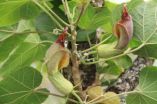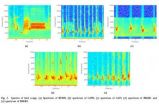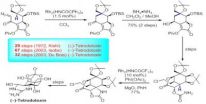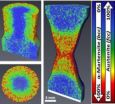(Press-News.org) BOZEMAN, Mont. – In the same week that the U.S. surgeon general issued a 101-page report about the dangers of skin cancer, researchers at Montana State University published a paper breaking new ground on how DNA – the genetic code in every cell – responds when exposed to ultraviolet (UV) light.
The findings advance fundamental understanding of DNA damage by the UV rays found in sunlight. This damage can lead to skin cancer, aging and some degenerative eye diseases.
"Our paper advances foundational knowledge about how DNA responds to UV radiation. In our experiments, we observe the earliest events immediately after DNA is energized by UV radiation. These events determine whether or not DNA is damaged," said one of the paper's co-authors, Bern Kohler, an MSU professor in the Department of Chemistry and Biochemistry.
DNA is built like a staircase and carries genetic instructions that are unique to each person. It's very hardy and generally able to stand up to ultraviolet rays, but UV rays sometimes cause mutations. UV exposure is a major cause of skin cancer, and while there are nearly 5 million cases of skin cancer each year in the U.S. alone – and 9,000 related deaths – the numbers would be far worse if DNA were more easily damaged.
"UV is actually very damaging, yet our DNA is damaged less than expected," Kohler said. "In the early evolution of life on Earth when there was no ozone layer, the amount of UV would have been far higher and yet life, and the DNA that is central to life, survived. We've been trying to understand the molecular mechanisms that make DNA resist UV damage."
In a paper published July 28 in the online version of the scientific journal, "Proceedings of the National Academy of Sciences" (PNAS), Kohler and his colleagues from MSU, Utah and Italy describe how DNA has a super-fast way of shrugging off the UV threat.
Too quick for the eye to see, UV light causes an electron to be transferred from one base to another on a single DNA strand. A base is the smallest unit of the genetic code, a small molecule that constitutes an individual "rung" on DNA's ladder.
In a next-generation solar cell, light also transfers electrons, but in DNA, the researchers observe that the transferred electron returns to its starting point in a fraction of a nanosecond. The back-and-forth motion of the electron explains how DNA remains undamaged most of the time. At the same time, the researchers note that the transferred electron could be used to repair damage in a way that mimics how certain repair proteins fix UV damage.
The finding is the latest in Kohler's 15-year search to understand what happens to DNA when it absorbs UV light.
The new discovery was possible because of a "lovely" infrared laser instrument built by Yuyuan (Tom) Zhang, an expert in ultrafast spectroscopy, a postdoctoral researcher at MSU and first author of the PNAS paper, Kohler said.
Zhang came to MSU about two years ago, and his first job was building the instrument that's the only one of its kind in Montana and one of only a handful in the world. The instrument shoots extremely short pulses of ultraviolet light at DNA samples, then measures the vibrations created in DNA in response. The vibrations are so fast that Kohler describes their speed in terms of femtoseconds instead of nanoseconds. A femtosecond is one millionth of a nanosecond. A nanosecond is one billionth of a second.
By analyzing those vibrations, the research team was able to determine that one base in a single strand of DNA transfers an electron to an adjacent base on the same strand when excited by UV light (or radiation), Kohler said. He added that molecules constantly vibrate, and light absorption leads to even greater vibrations. Removing or adding an electron causes changes to the pattern of vibrations, and that is what the MSU team measured in the lab.
The instrument they used takes up most of a room in MSU's Chemistry and Biochemistry Building. It incorporates black boxes, mirrors, stacked razor blades, tiny plastic tubes and what looks like a fish tank, with every component having a purpose and a place on the steel optical tables that hold them. The razor blades, for example, block laser beams. The mirrors direct light to the "fish tank," which holds DNA samples. The air inside the tank is drier than any desert so it won't contain the water vapor or carbon dioxide that could interfere with experiments.
Zhang said it took him three months to develop the instrument. Kohler said the instrument was critical for the DNA study, but yet it is available to MSU undergraduates and others who are trained to use it.
INFORMATION:
Jordan Dood of Bozeman, for one, was an undergraduate when he learned how to use the instrument. The recent MSU graduate is now a co-author on the PNAS paper – his second published paper – and about to leave Montana to attend graduate school at the University of Buffalo in New York.
The fourth MSU co-author of the PNAS paper is graduate student Ashley Beckstead from Casper, Wyo. Other co-authors are Xi-Bo Li, Khiem Nguyen and Cynthia Burrows at the University of Utah in Salt Lake City, and Roberto Improta at the Istituto di Biostrutture e Bioimmagini in Naples, Italy.
The work performed at MSU for this study was funded by the National Science Foundation and the NASA Astrobiology Program. Zhang developed the laser instrument with funding from the M.J. Murdock Charitable Trust.
INFORMATION: END
New paper describes how DNA avoids damage from UV light
2014-07-31
ELSE PRESS RELEASES FROM THIS DATE:
Magnetic resonance imaging in patients with transient ischemic attack
2014-07-31
Transient ischemic attack (TIA) is a temporary event, which portends a higher risk of a disabling stroke following the TIA. However, the evaluation and management of TIA vary worldwide and is debated and controversial. Dr. Mohamed Al-Khaled from University of Lübeck in Germany considered With the development of brain imaging, particularly diffusion weighted imaging-magnetic resonance imaging (DWI-MRI), the diagnosis of TIA changed from time-based definition to a tissue-based one. DWI-MRI became a mandatory tool in the TIA workup. The DWI-MRI provides not only the evidence ...
Ligaments disruption: A new perspective in the prognosis of SCI
2014-07-31
Worldwide prevalence of Spinal Cord Injury (SCI) is ranging from 233 to 755 per million inhabitants, whereas reported incidence lies between 10.4 and 83 per million inhabitants per year. Thus, the socioeconomic impact of SCI associated with cervical trauma is high enough to be encountered within one of the most important worries in vast majority of developed countries.
The ability to predict recovery following SCI is of paramount importance to the physician's role in providing the best care and guidance to patients and families during the illness. Diagnosis of cervical ...
Brother of Hibiscus is found alive and well on Maui
2014-07-31
Most people are familiar with Hibiscus flowers- they are an iconic symbol of tropical resorts worldwide where they are commonly planted in the landscape. Some, like Hawaii's State Flower- Hibiscus brackenridgei- are endangered species.
Only a relatively few botanists and Hawaiian conservation workers, however, are aware of an equally beautiful and intriguing related group of plants known as Hibiscadelphus- literally "brother of Hibiscus".
Brother of Hibiscus species are in fact highly endangered. Until recently only one of the seven previously known species remained ...
Singing the same tune: Scientists develop novel ways of separating birdsong sources
2014-07-31
Researchers at the University of California, Los Angeles and the Chinese Academy of Sciences have pioneered a new study that could greatly improve current methods of localising birdsong data. Their findings, which ascertain the validity of using statistical algorithms to detect multiple-source signals in real time and in three-dimensional space, are of especial significance to modern warfare.
Recently published in the journal Unmanned Systems, the study demonstrates the validity of using approximate maximum likelihood (AML) algorithms to determine the direction of arrival ...
Gulf oil spill researcher: Bacteria ate some toxins, but worst remain
2014-07-31
TALLAHASSEE, Fla. — A Florida State University researcher found that bacteria in the Gulf of Mexico consumed many of the toxic components of the oil released during the Deepwater Horizon spill in the months after the spill, but not the most toxic contaminants.
In two new studies conducted in a deep sea plume, Assistant Professor Olivia Mason found a species of bacteria called Colwellia likely consumed gaseous hydrocarbons and perhaps benzene, toluene, ethylbenzene and xylene compounds that were released as part of the oil spill.
But, her research also showed that bacteria ...
Hope for the overweight
2014-07-31
White, brown and beige adipocytes, or fat cells, are inherently different. Each of these cell types has different functions and each plays its own role in metabolism. In the human body, white adipose tissue is by far the most prevalent. Its primary function is energy storage. On the other hand, brown adipocytes utilize available energy to generate heat but are only found in a few places in the adult human body. Beige adipocytes, which represent a special type of brown adipocytes, appear mixed with brown adipocytes in human brown adipose tissue or develop within the white ...
Privileged strategies for direct transformations of inert aliphatic carbon-hydrogen bonds
2014-07-31
Functional group transformations are central to organic synthesis. Traditionally, the functionalities used in such transformations are highly active organic groups such as halogens, ester groups and hydroxyl groups. Carbon–hydrogen bonds are ubiquitous structural motifs in organic compounds, but they are not considered to be functional groups because (1) in general, the bond dissociation energy of a C–H bond is high, and therefore, such bonds are thermodynamically hard to break; and (2) the selective activation of one C–H bond among many similar and different C–H bonds ...
Neutron tomography technique reveals phase fractions of crystalline materials in 3-dimensions
2014-07-31
The method overcomes limitations of existing techniques which are limited to the surface or small-sized specimens, and allows a 3-D representation of the phase fractions within the sample volume. The work has just been published in the journal "Advanced Materials".
"For many engineering applications it is of major importance to characterize the bulk of materials spatially, instead of only probing selected locations. The new method provides exactly that capability, and the HZB-UTK team has demonstrated it by using samples made from stainless steel that undergo a phase ...
Vision-correcting electronic displays could let users dispense with glasses
2014-07-31
Researchers at the MIT Media Laboratory and the University of California at Berkeley have developed a new display technology that automatically corrects for vision defects — no glasses (or contact lenses) required.
The technique could lead to dashboard-mounted GPS displays that farsighted drivers can consult without putting their glasses on, or electronic readers that eliminate the need for reading glasses, among other applications.
"The first spectacles were invented in the 13th century," says Gordon Wetzstein, a research scientist at the Media Lab and one of the display's ...
Vacuum treatment may limit damage after traumatic brain injury
2014-07-31
July 31, 2014 – Controlled application of vacuum pressure is a promising approach to limiting tissue damage after traumatic brain injury (TBI), suggests an experimental study in the August issue of Neurosurgery, official journal of the Congress of Neurological Surgeons. The journal is published by Lippincott Williams & Wilkins, a part of Wolters Kluwer Health.
"Mechanical tissue resuscitation"—consisting of vacuum pressure applied over the injured area of the brain—shows promise as a safe and effective treatment for TBI, according to the research report by Dr. Louis ...



